Abstract
Under appropriate conditions, deficiencies of certain minerals and vitamins as well as high intakes of dietary fat increase the toxicity of a given dose of lead in experimental animals. The severity of lead poisoning can also be increased by the consumption of either deficient or excessive levels of protein. Mineral deficiencies appear to have some of the most profound effects on lead toxicity, since the consequences of plumbism can be exaggerated by feeding diets low in calcium, phosphorus, iron, zinc, and in some cases, copper. Evidence for an antagonism between lead and nutritional levels of selenium is inconclusive. Vitamin E deficiency and lead poisoning interact to produce an anemia in rats that is more severe than that caused by either treatment alone. Lead apparently exerts a pro-oxidant stress on the red cell, thereby causing its accelerated destruction. One of the biochemical mechanisms of lead poisoning may be the disruption of normal membrane architecture, thereby leading to peroxidative damage. Epidemiological surveys have suggested a negative correlation between the poor nutritional status of children with regard to calcium and the concentration of lead in blood. Other examples of potential interactions of mineral status and lead poisoning in humans include the hypothesized hazards of soft water to public health in areas with lead plumbing and the possible role of mineral deficiencies in the etiology of pica. Experimental studies have shown that in some situations combined nutritional deficiencies can have an additive effect in potentiating lead toxicity.
Full text
PDF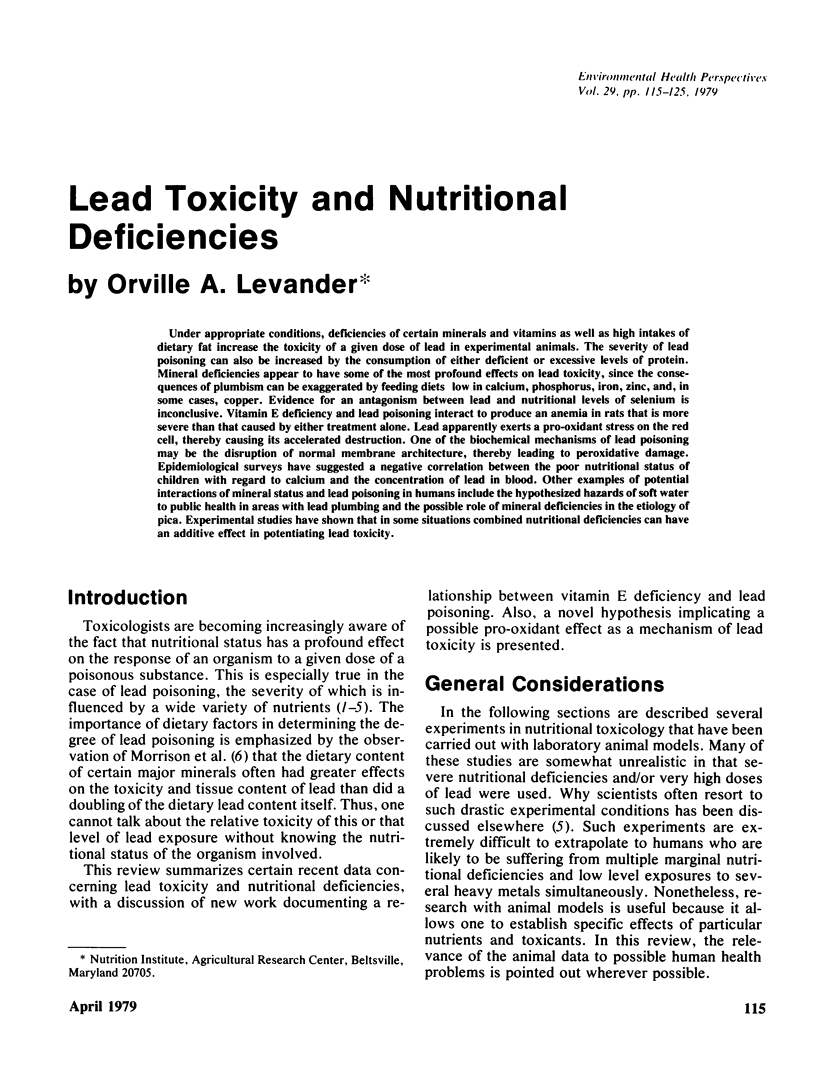
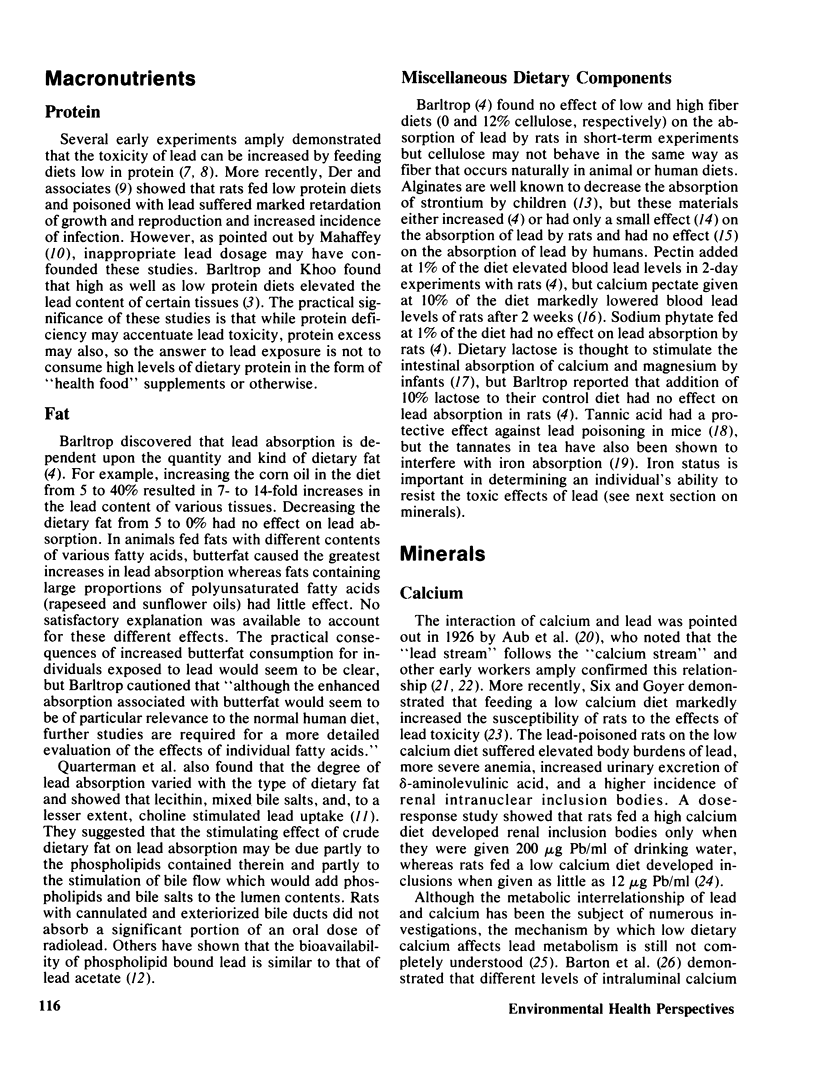
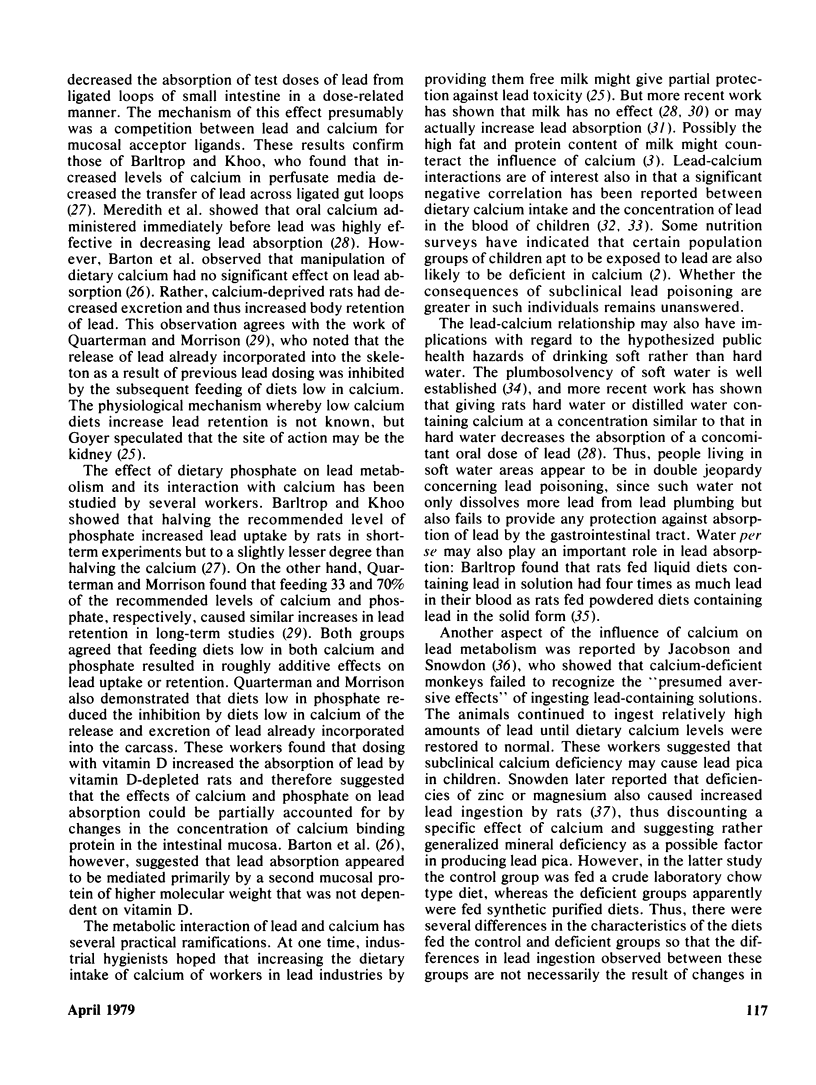
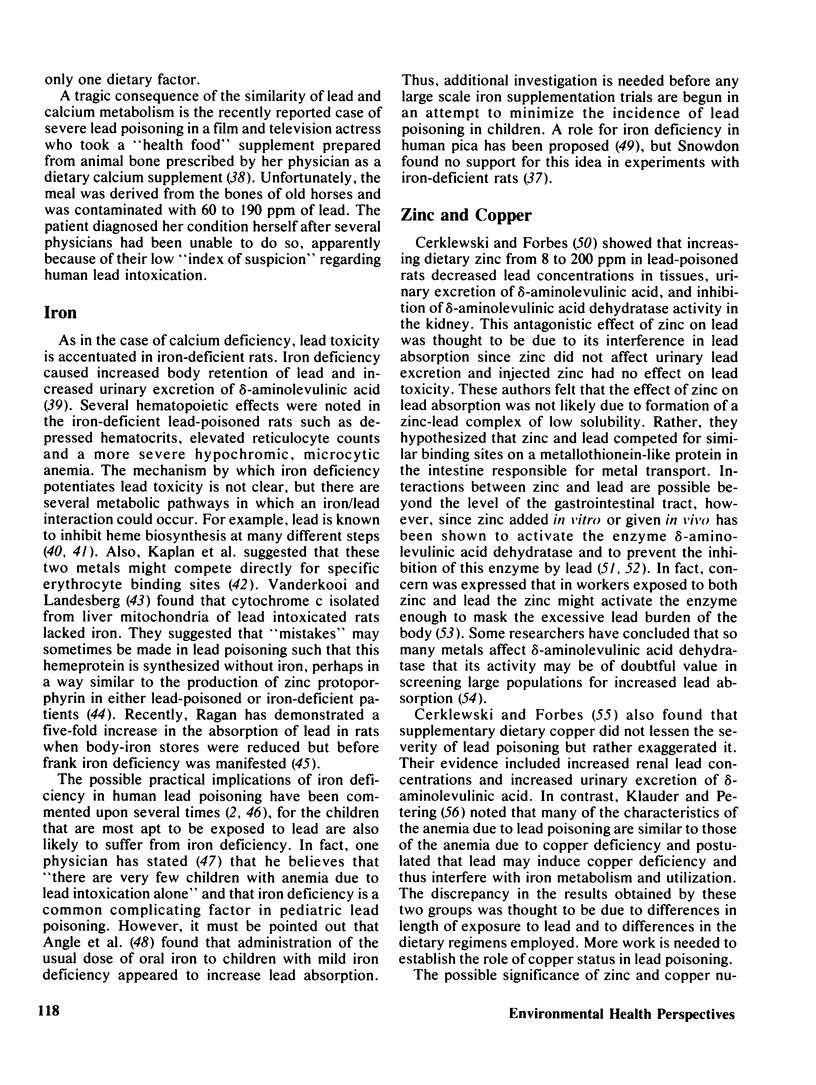
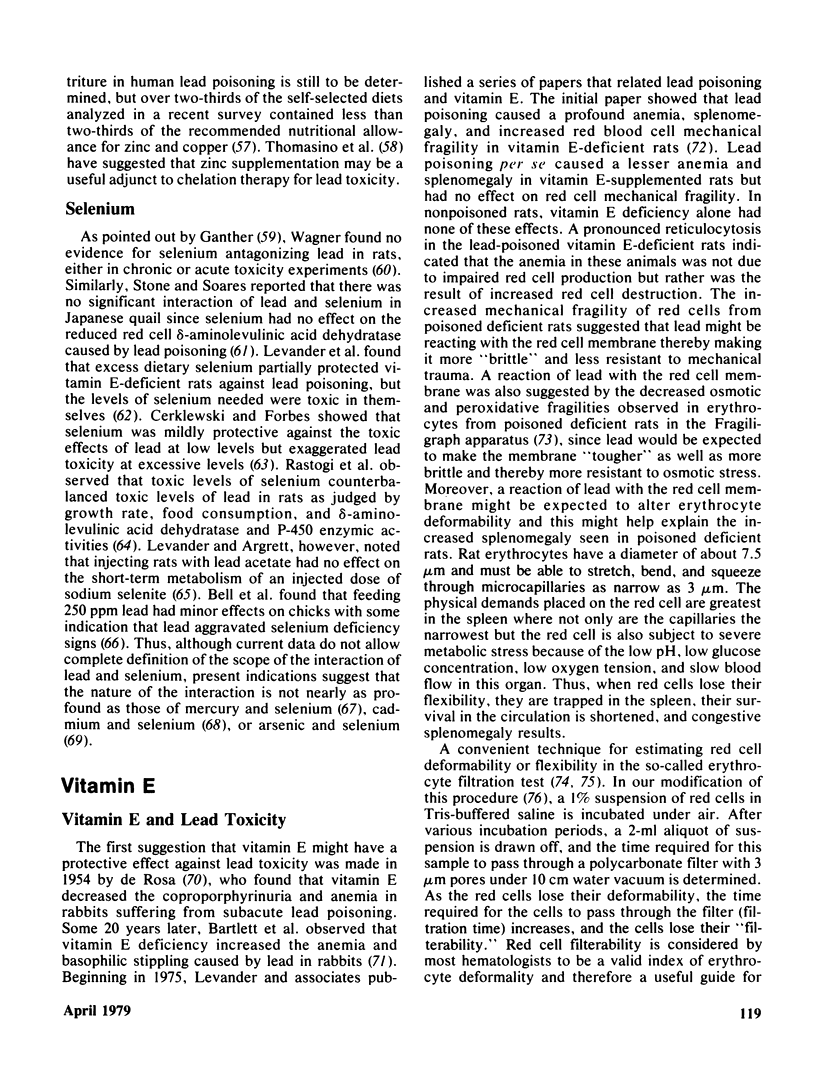

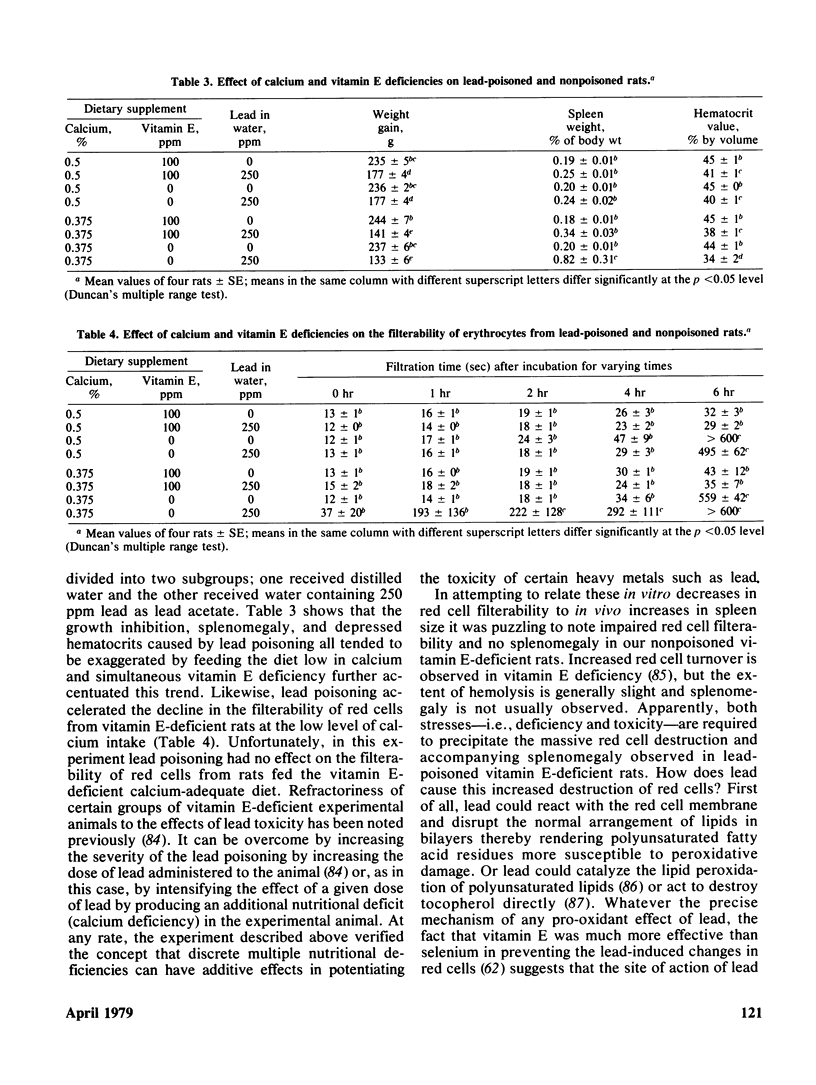
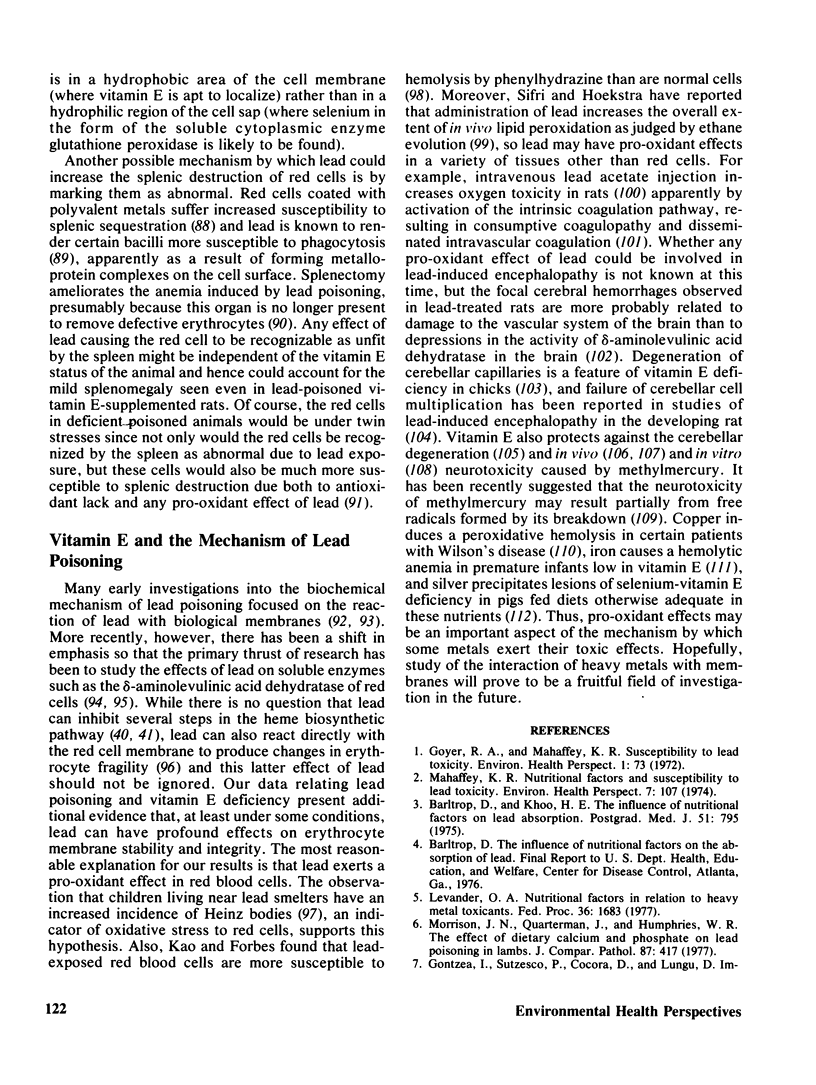
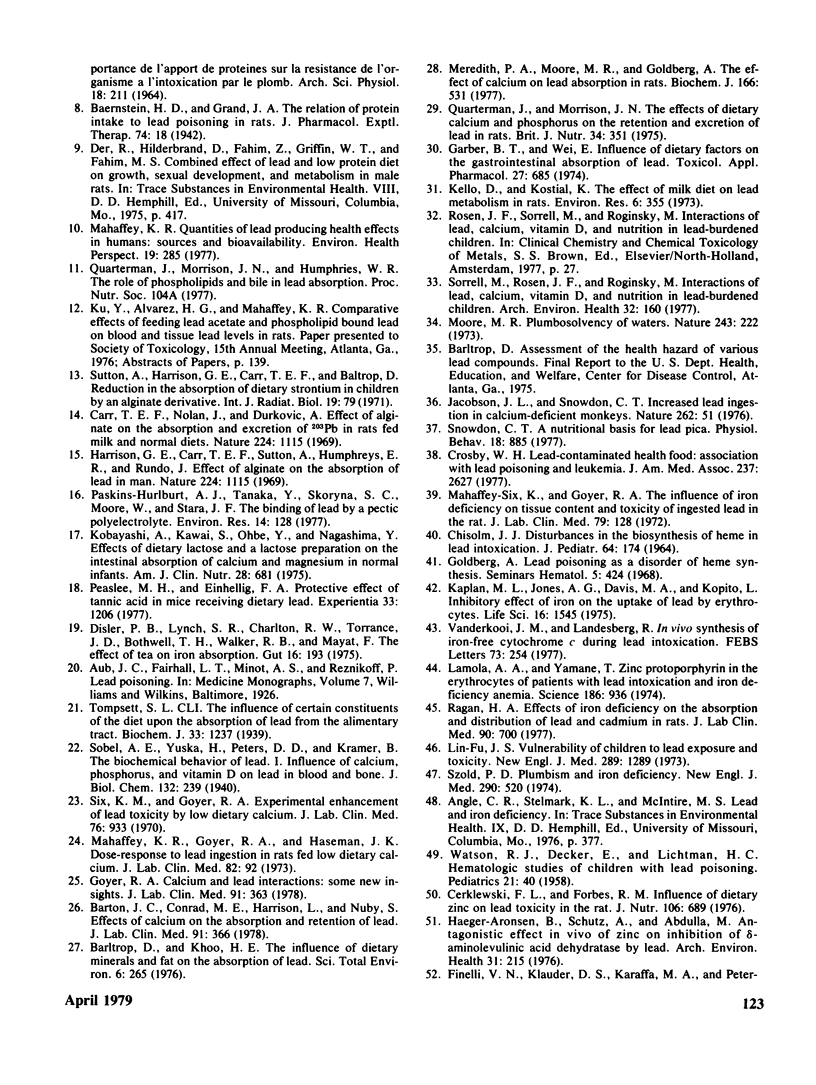
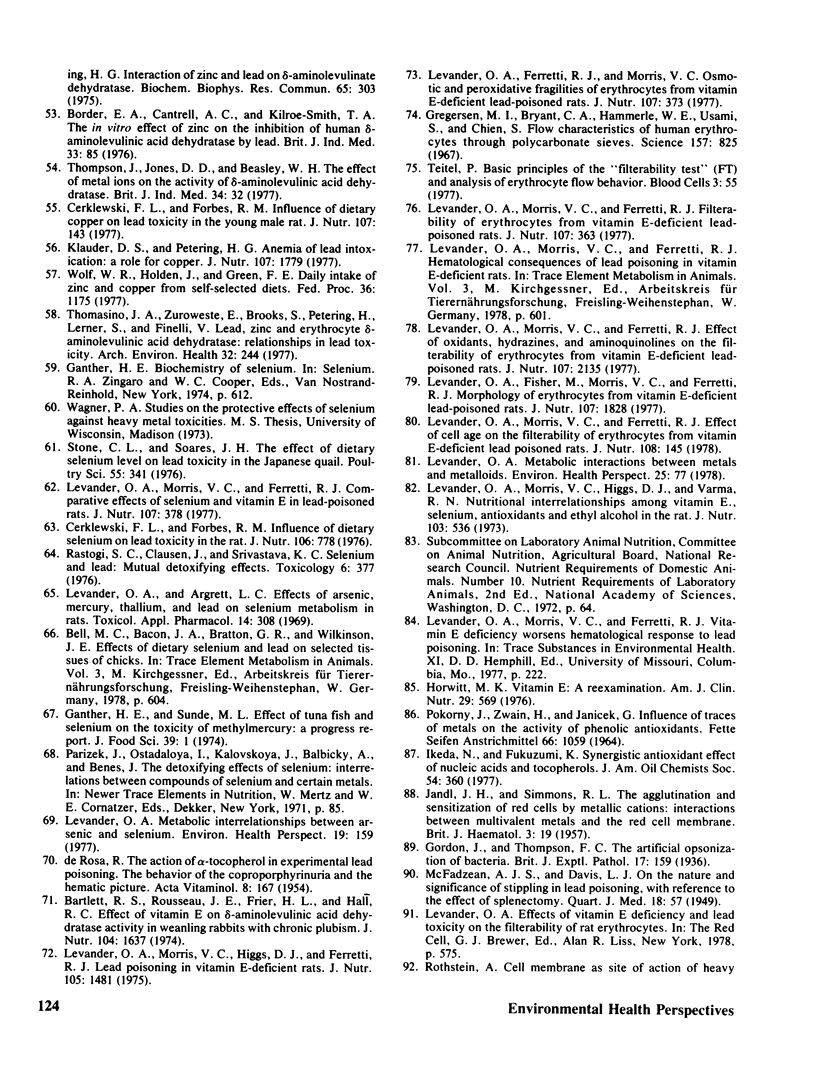
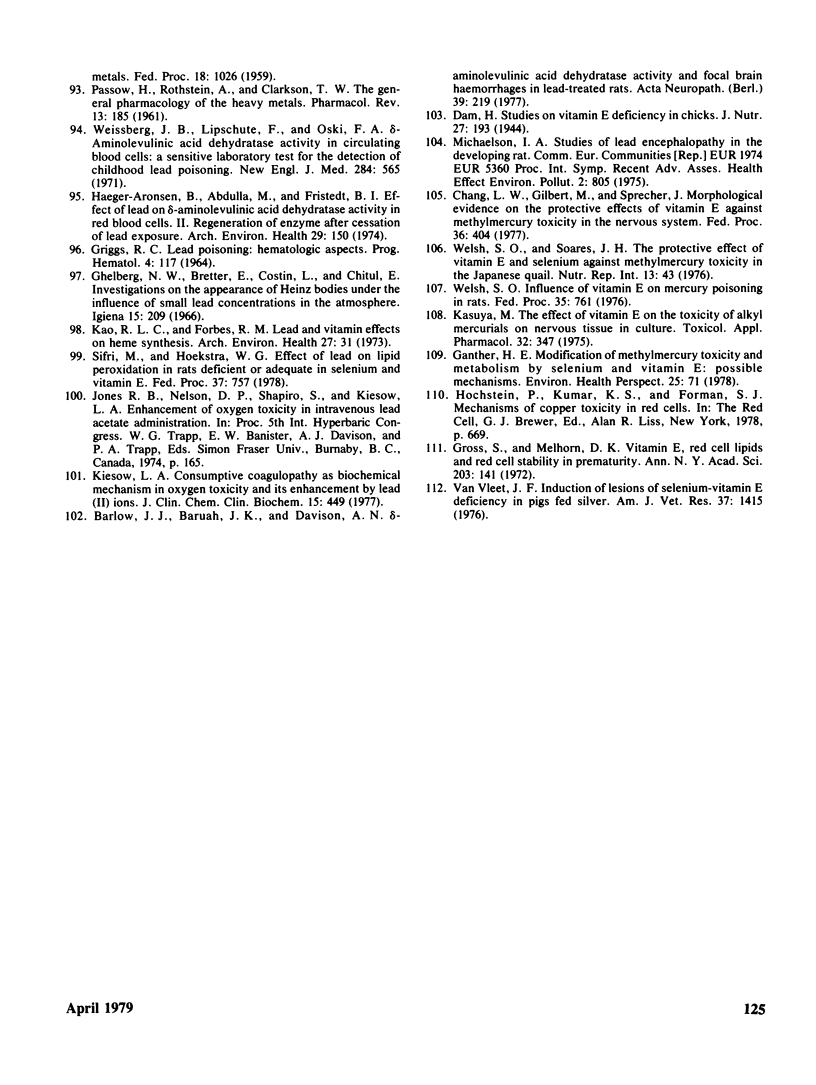
Selected References
These references are in PubMed. This may not be the complete list of references from this article.
- Barltrop D., Khoo H. E. The influence of dietary minerals and fat on the absorption of lead. Sci Total Environ. 1976 Nov;6(3):265–273. doi: 10.1016/0048-9697(76)90036-x. [DOI] [PubMed] [Google Scholar]
- Barltrop D., Khoo H. E. The influence of nutritional factors on lead absorption. Postgrad Med J. 1975 Nov;51(601):795–800. doi: 10.1136/pgmj.51.601.795. [DOI] [PMC free article] [PubMed] [Google Scholar]
- Bartlett R. S., Rousseau J. E., Jr, Frier H. I., Hall R. C., Jr Effect of vitamin E on delta-aminolevulinic acid dehydratase activity in weanling rabbits with chronic plumbism. J Nutr. 1974 Dec;104(12):1637–1645. doi: 10.1093/jn/104.12.1637. [DOI] [PubMed] [Google Scholar]
- Barton J. C., Conrad M. E., Harrison L., Nuby S. Effects of calcium on the absorption and retention of lead. J Lab Clin Med. 1978 Mar;91(3):366–376. [PubMed] [Google Scholar]
- Border E. A., Cantrell A. C., Kilroe-Smith T. A. The in vitro effect of zinc on the inhibition of human delta-aminolevulinic acid dehydratase by lead. Br J Ind Med. 1976 May;33(2):85–87. doi: 10.1136/oem.33.2.85. [DOI] [PMC free article] [PubMed] [Google Scholar]
- CHISOLM J. J., Jr V/. J Pediatr. 1964 Feb;64:174–187. doi: 10.1016/s0022-3476(64)80261-4. [DOI] [PubMed] [Google Scholar]
- Carr T. E., Nolan J., Duraković A. Effect of alginate on the absorption and excretion of 203Pb in rats fed milk and normal diets. Nature. 1969 Dec 13;224(5224):1115–1115. doi: 10.1038/2241115a0. [DOI] [PubMed] [Google Scholar]
- Cerklewski F. L., Forbes R. M. Influence of dietary copper on lead toxicity in the young male rat. J Nutr. 1977 Jan;107(1):143–146. doi: 10.1093/jn/107.1.143. [DOI] [PubMed] [Google Scholar]
- Cerklewski F. L., Forbes R. M. Influence of dietary selenium on lead toxicity in the rat. J Nutr. 1976 Jun;106(6):778–783. doi: 10.1093/jn/106.6.778. [DOI] [PubMed] [Google Scholar]
- Cerklewski F. L., Forbes R. M. Influence of dietary zinc on lead toxicity in the rat. J Nutr. 1976 May;106(5):689–696. doi: 10.1093/jn/106.5.689. [DOI] [PubMed] [Google Scholar]
- Crosby W. H. Lead-contaminated health food. Association with lead poisoning and leukemia. JAMA. 1977 Jun 13;237(24):2627–2629. [PubMed] [Google Scholar]
- DE ROSA R. L'azione dell'alfa-tocoferolo nella intossicazione sperimentale da piombo; comportamento della coproporfirinuria e della crasi ematica. Acta Vitaminol. 1954 Aug;8(4):167–172. [PubMed] [Google Scholar]
- Disler P. B., Lynch S. R., Charlton R. W., Torrance J. D., Bothwell T. H., Walker R. B., Mayet F. The effect of tea on iron absorption. Gut. 1975 Mar;16(3):193–200. doi: 10.1136/gut.16.3.193. [DOI] [PMC free article] [PubMed] [Google Scholar]
- GRIGGS R. C. LEAD POISONING: HEMATOLOGIC ASPECTS. Prog Hematol. 1964;4:117–137. [PubMed] [Google Scholar]
- Ganther H. E. Modification of methylmercury toxicity and metabolism by selenium and vitamin E: possible mechanisms. Environ Health Perspect. 1978 Aug;25:71–76. doi: 10.1289/ehp.782571. [DOI] [PMC free article] [PubMed] [Google Scholar]
- Garber B. T., Wei E. Influence of dietary factors on the gastrointestinal absorption of lead. Toxicol Appl Pharmacol. 1974 Mar;27(3):685–691. doi: 10.1016/0041-008x(74)90048-9. [DOI] [PubMed] [Google Scholar]
- Goldberg A. Lead poisoning as a disorder of heme synthesis. Semin Hematol. 1968 Oct;5(4):424–433. [PubMed] [Google Scholar]
- Goyer R. A. Calcium and lead interactions: some new insights. J Lab Clin Med. 1978 Mar;91(3):363–365. [PubMed] [Google Scholar]
- Goyer R. A., Mahaffey K. R. Susceptibility to lead toxicity. Environ Health Perspect. 1972 Oct;2:73–80. doi: 10.1289/ehp.720273. [DOI] [PMC free article] [PubMed] [Google Scholar]
- Gregersen M. I., Bryant C. A., Hammerle W. E., Usami S., Chien S. Flow Characteristics of Human Erythrocytes through Polycarbonate Sieves. Science. 1967 Aug 18;157(3790):825–827. doi: 10.1126/science.157.3790.825. [DOI] [PubMed] [Google Scholar]
- Gross S., Melhorn D. K. Vitamin E, red cell lipids and red cell stability in prematurity. Ann N Y Acad Sci. 1972 Dec 18;203:141–162. doi: 10.1111/j.1749-6632.1972.tb27868.x. [DOI] [PubMed] [Google Scholar]
- Haeger-Aronsen B., Abdulla M., Fristedt B. I. Effect of lead on delta-aminolevulinic acid dehydratase activity in red blood cells. II. Regeneration of enzyme after cessation of lead exposure. Arch Environ Health. 1974 Sep;29(3):150–153. doi: 10.1080/00039896.1974.10666553. [DOI] [PubMed] [Google Scholar]
- Haeger-Aronsen B., Schütz A. Antagonistic effect in vivo of zinc on inhibition of delta-aminolevulinic acid dehydratase by lead. Arch Environ Health. 1976 Jul-Aug;31(4):215–220. doi: 10.1080/00039896.1976.10667222. [DOI] [PubMed] [Google Scholar]
- Harrison G. E., Carr T. E., Sutton A., Humphreys E. R., Rundo J. Effect of alginate on the absorption of lead in man. Nature. 1969 Dec 13;224(5224):1115–1116. doi: 10.1038/2241115b0. [DOI] [PubMed] [Google Scholar]
- Hochstein P., Kumar K. S., Forman S. J. Mechanisms of copper toxicity in red cells. Prog Clin Biol Res. 1978;21:669–686. [PubMed] [Google Scholar]
- Horwitt M. K. Vitamin E: a reexamination. Am J Clin Nutr. 1976 May;29(5):569–578. doi: 10.1093/ajcn/29.5.569. [DOI] [PubMed] [Google Scholar]
- Ikeda N., Fukuzumi K. Synergistic antioxidant effect of nucleic acids and tocopherols. J Am Oil Chem Soc. 1977 Sep;54(9):360–366. doi: 10.1007/BF02802036. [DOI] [PubMed] [Google Scholar]
- JANDL J. H., SIMMONS R. L. The agglutination and sensitization of red cells by metallic cations: interactions between multivalent metals and the red-cell membrane. Br J Haematol. 1957 Jan;3(1):19–38. doi: 10.1111/j.1365-2141.1957.tb05768.x. [DOI] [PubMed] [Google Scholar]
- Jacobson J. L., Snowdon C. T. Increased lead ingestion in calcium-deficient monkeys. Nature. 1976 Jul 1;262(5563):51–52. doi: 10.1038/262051a0. [DOI] [PubMed] [Google Scholar]
- Kao R. L., Forbes R. M. Lead and vitamin effects on heme synthesis. Arch Environ Health. 1973 Jul;27(1):31–35. doi: 10.1080/00039896.1973.10666303. [DOI] [PubMed] [Google Scholar]
- Kaplan M. L., Jones A. G., Davis M. A., Kopito L. Inhibitory effect of iron on the uptake of lead by erythrocytes. Life Sci. 1975 May 15;16(10):1545–1554. doi: 10.1016/0024-3205(75)90072-7. [DOI] [PubMed] [Google Scholar]
- Kasuya M. The effect of vitamin E on the toxicity of alkyl mercurials on nervous tissue in culture. Toxicol Appl Pharmacol. 1975 May;32(2):347–354. doi: 10.1016/0041-008x(75)90225-2. [DOI] [PubMed] [Google Scholar]
- Kello D., Kostial K. The effect of milk diet on lead metabolism in rats. Environ Res. 1973 Sep;6(3):355–360. doi: 10.1016/0013-9351(73)90048-0. [DOI] [PubMed] [Google Scholar]
- Kiesow L. A. Consumptive coagulopathy as biochemical mechanism in oxygen toxicity and its enhancement by lead(II) ions. J Clin Chem Clin Biochem. 1977 Aug;15(8):449–453. doi: 10.1515/cclm.1977.15.1-12.449. [DOI] [PubMed] [Google Scholar]
- Klauder D. S., Petering H. G. Anemia of lead intoxication: a role for copper. J Nutr. 1977 Oct;107(10):1779–1785. doi: 10.1093/jn/107.10.1779. [DOI] [PubMed] [Google Scholar]
- Kobayashi A., Kawai S., Obe Y., Nagashima Y. Effects of dietary lactose and lactase preparation on the intestinal absorption of calcium and magnesium in normal infants. Am J Clin Nutr. 1975 Jul;28(7):681–683. doi: 10.1093/ajcn/28.7.681. [DOI] [PubMed] [Google Scholar]
- Lamola A. A., Yamane T. Zinc protoporphyrin in the erythrocytes of patients with lead intoxication and iron deficiency anemia. Science. 1974 Dec 6;186(4167):936–938. doi: 10.1126/science.186.4167.936. [DOI] [PubMed] [Google Scholar]
- Levander O. A., Argrett L. C. Effects of arsenic, mercury, thallium, and lead on selenium metabolism in rats. Toxicol Appl Pharmacol. 1969 Mar;14(2):308–314. doi: 10.1016/0041-008x(69)90112-4. [DOI] [PubMed] [Google Scholar]
- Levander O. A., Ferretti R. J., Morris V. C. Osmotic and peroxidative fragilities of erythrocytes from vitamin E-deficient lead-poisoned rats. J Nutr. 1977 Mar;107(3):373–377. doi: 10.1093/jn/107.3.373. [DOI] [PubMed] [Google Scholar]
- Levander O. A., Fisher M., Morris V. C., Ferretti R. J. Morphology of erythrocytes from vitamin E-deficient lead-poisoned rats. J Nutr. 1977 Oct;107(10):1828–1836. doi: 10.1093/jn/107.10.1828. [DOI] [PubMed] [Google Scholar]
- Levander O. A. Metabolic interactions between metals and metalloids. Environ Health Perspect. 1978 Aug;25:77–80. doi: 10.1289/ehp.782577. [DOI] [PMC free article] [PubMed] [Google Scholar]
- Levander O. A. Metabolic interrelationships between arsenic and selenium. Environ Health Perspect. 1977 Aug;19:159–164. doi: 10.1289/ehp.7719159. [DOI] [PMC free article] [PubMed] [Google Scholar]
- Levander O. A., Morris V. C., Ferretti R. J. Comparative effects of selenium and vitamin E in lead-poisoned rats. J Nutr. 1977 Mar;107(3):378–372. doi: 10.1093/jn/107.3.378. [DOI] [PubMed] [Google Scholar]
- Levander O. A., Morris V. C., Ferretti R. J. Effect of cell age on the filterability of erythrocytes from vitamin E-deficient lead-poisoned rats. J Nutr. 1978 Jan;108(1):145–151. doi: 10.1093/jn/108.1.145. [DOI] [PubMed] [Google Scholar]
- Levander O. A., Morris V. C., Ferretti R. J. Effect of oxidants, hydrazines, and aminoquinolines on the filterability of erythrocytes from vitamin E-deficient lead-poisoned rats. J Nutr. 1977 Dec;107(12):2135–2143. doi: 10.1093/jn/107.12.2135. [DOI] [PubMed] [Google Scholar]
- Levander O. A., Morris V. C., Ferretti R. J. Effects of vitamin E deficiency and lead toxicity on the filterability of rat erythrocytes. Prog Clin Biol Res. 1978;21:575–593. [PubMed] [Google Scholar]
- Levander O. A., Morris V. C., Ferretti R. J. Filterability of erythrocytes from vitamin E-deficient lead-poisoned rats. J Nutr. 1977 Mar;107(3):363–372. doi: 10.1093/jn/107.3.363. [DOI] [PubMed] [Google Scholar]
- Levander O. A., Morris V. C., Higgs D. J., Ferretti R. J. Lead poisoning in vitamin E-deficient rats. J Nutr. 1975 Nov;105(11):1481–1485. doi: 10.1093/jn/105.11.1481. [DOI] [PubMed] [Google Scholar]
- Levander O. A., Morris V. C., Higgs D. J., Varma R. N. Nutritional interrelationships among vitamin E, selenium, antioxidants and ethyl alcohol in the rat. J Nutr. 1973 Apr;103(4):536–542. doi: 10.1093/jn/103.4.536. [DOI] [PubMed] [Google Scholar]
- Levander O. A. Nutritional factors in relation to heavy metal toxicants. Fed Proc. 1977 Apr;36(5):1683–1687. [PubMed] [Google Scholar]
- Lin-Fu J. S. Vulnerability of children to lead exposure and toxicity (second of two parts). N Engl J Med. 1973 Dec 13;289(24):1289–1293. doi: 10.1056/NEJM197312132892407. [DOI] [PubMed] [Google Scholar]
- Mahaffey K. R., Goyer R., Haseman J. K. Dose-response to lead ingestion in rats fed low dietary calcium. J Lab Clin Med. 1973 Jul;82(1):92–100. [PubMed] [Google Scholar]
- Mahaffey K. R. Nutritional factors and susceptibility to lead toxicity. Environ Health Perspect. 1974 May;7:107–112. doi: 10.1289/ehp.747107. [DOI] [PMC free article] [PubMed] [Google Scholar]
- Mahaffey K. R. Quantities of lead producing health effects in humans: sources and bioavailability. Environ Health Perspect. 1977 Aug;19:285–295. doi: 10.1289/ehp.7719285. [DOI] [PMC free article] [PubMed] [Google Scholar]
- Meredith P. A., Moore M. R., Goldberg A. The effect of calcium on lead absorption in rats. Biochem J. 1977 Sep 15;166(3):531–537. doi: 10.1042/bj1660531. [DOI] [PMC free article] [PubMed] [Google Scholar]
- Morrison J. N., Quarterman J., Humphries W. R. The effect of dietary calcium and phosphate on lead poisoning in lambs. J Comp Pathol. 1977 Jul;87(3):417–429. doi: 10.1016/0021-9975(77)90031-7. [DOI] [PubMed] [Google Scholar]
- PASSOW H., ROTHSTEIN A., CLARKSON T. W. The general pharmacology of the heavy metals. Pharmacol Rev. 1961 Jun;13:185–224. [PubMed] [Google Scholar]
- Paskins-Hurlburt A. J., Tanaka Y., Skoryna S. C., Moore W., Jr, Stara J. F. The binding of lead by a pectic polyelectrolyte. Environ Res. 1977 Aug;14(1):128–140. doi: 10.1016/0013-9351(77)90074-3. [DOI] [PubMed] [Google Scholar]
- Peaslee M. H., Einhellig F. A. Protective effect of tannic acid in mice receiving dietary lead. Experientia. 1977 Sep 15;33(9):1206–1206. doi: 10.1007/BF01922331. [DOI] [PubMed] [Google Scholar]
- Quarterman J., Morrison J. N. The effects of dietary calcium and phosphorus on the retention and excretion of lead in rats. Br J Nutr. 1975 Nov;34(3):351–362. doi: 10.1017/s0007114575000414. [DOI] [PubMed] [Google Scholar]
- ROTHSTEIN A. Cell membrane as site of action of heavy metals. Fed Proc. 1959 Dec;18:1026–1038. [PubMed] [Google Scholar]
- Ragan H. A. Effects of iron deficiency on the absorption and distribution of lead and cadmium in rats. J Lab Clin Med. 1977 Oct;90(4):700–706. [PubMed] [Google Scholar]
- Rastogi S. C., Clausen J., Srivastava K. C. Selenium and lead: mutual detoxifying effects. Toxicology. 1976 Nov-Dec;6(3):377–388. doi: 10.1016/0300-483x(76)90041-x. [DOI] [PubMed] [Google Scholar]
- Six K. M., Goyer R. A. Experimental enhancement of lead toxicity by low dietary calcium. J Lab Clin Med. 1970 Dec;76(6):933–942. [PubMed] [Google Scholar]
- Six K. M., Goyer R. A. The influence of iron deficiency on tissue content and toxicity of ingested lead in the rat. J Lab Clin Med. 1972 Jan;79(1):128–136. [PubMed] [Google Scholar]
- Snowdon C. T. A nutritional basis for lead pica. Physiol Behav. 1977 May;18(5):885–893. doi: 10.1016/0031-9384(77)90198-6. [DOI] [PubMed] [Google Scholar]
- Sorrell M., Rosen J. F. Interactions of lead, calcium, vitamin D, and nutrition in lead-burdened children. Arch Environ Health. 1977 Jul-Aug;32(4):160–164. doi: 10.1080/00039896.1977.10667274. [DOI] [PubMed] [Google Scholar]
- Stone C. L., Soares J. H., Jr The effect of dietary selenium level on lead toxicity in the Japanese quail. Poult Sci. 1976 Jan;55(1):341–349. doi: 10.3382/ps.0550341. [DOI] [PubMed] [Google Scholar]
- Szold P. D. Letter: Plumbism and iron deficiency. N Engl J Med. 1974 Feb 28;290(9):520–520. doi: 10.1056/NEJM197402282900918. [DOI] [PubMed] [Google Scholar]
- Thomasino J. A., Zuroweste E., Brooks S. M., Petering H. G., Lerner S. I., Finelli V. N. Lead, zinc, and erythrocyte delta-aminolevulinic acid dehydratase: relationships in lead toxicity. Arch Environ Health. 1977 Nov-Dec;32(6):244–247. doi: 10.1080/00039896.1977.10667290. [DOI] [PubMed] [Google Scholar]
- Tompsett S. L. The influence of certain constituents of the diet upon the absorption of lead from the alimentary tract. Biochem J. 1939 Aug;33(8):1237–1240. doi: 10.1042/bj0331237. [DOI] [PMC free article] [PubMed] [Google Scholar]
- Van Vleet J. F. Induction of lesions of selenium-vitamin E deficiency in pigs fed silver. Am J Vet Res. 1976 Dec;37(12):1415–1420. [PubMed] [Google Scholar]
- Vanderkooi J. M., Landesberg R. In vivo synthesis of iron-free cytochrome c during lead intoxication. FEBS Lett. 1977 Feb 1;73(2):254–256. doi: 10.1016/0014-5793(77)80993-9. [DOI] [PubMed] [Google Scholar]
- WATSON J. R., DECKER E., LICHTMAN H. C. Hematologic studies of children with lead poisoning. Pediatrics. 1958 Jan;21(1):40–46. [PubMed] [Google Scholar]
- Weissberg J. B., Lipschutz F., Oski F. A. Delta-aminolevulinic acid dehydratase activity in circulating blood cells. A sensitive laboratory test for the detection of childhood lead poisoning. N Engl J Med. 1971 Mar 18;284(11):565–569. doi: 10.1056/NEJM197103182841101. [DOI] [PubMed] [Google Scholar]


